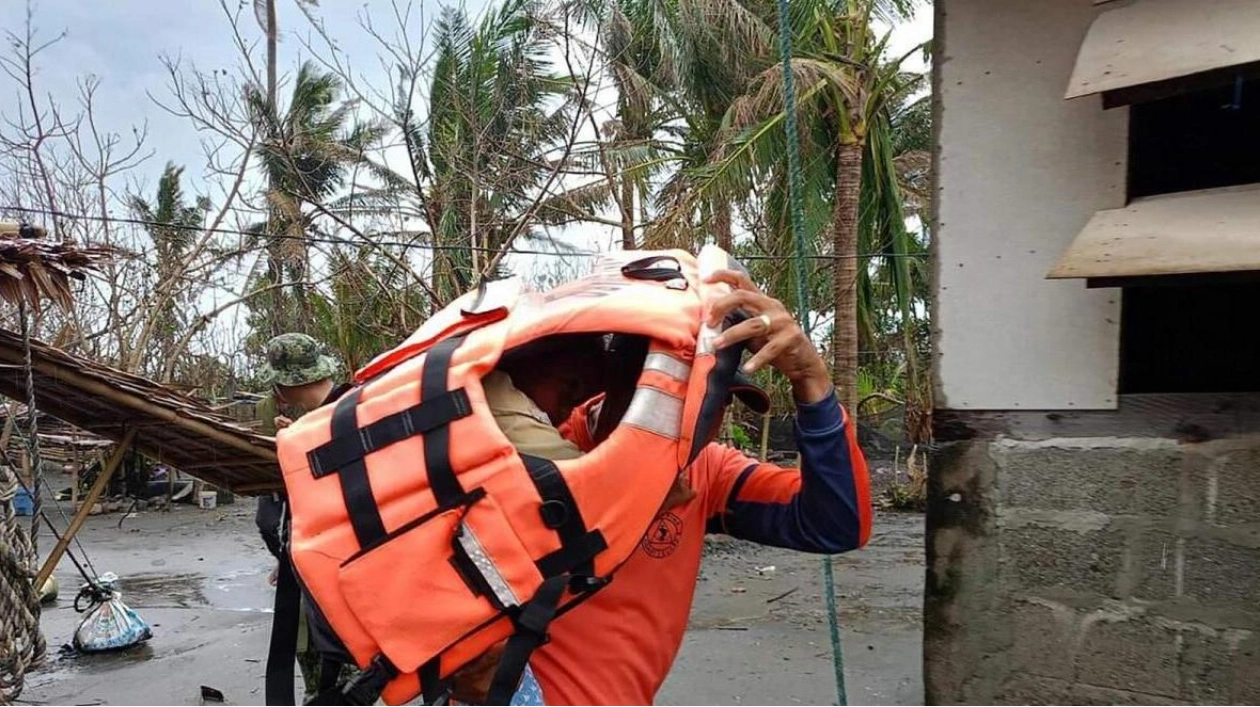A rescuer carrying a young resident during a forced evacuation operation in Buguey town, Cagayan province, north of Manila, on Thursday ahead of Super Typhoon Usagi's landfall. AFP
Typhoon Usagi made a devastating impact on the Philippines' already disaster-stricken northern region on Thursday, prompting authorities to urgently evacuate thousands from flood-prone areas. As the fifth storm to hit the country in just three weeks, Usagi made landfall in the town of Baggao in Cagayan province at 0530 GMT, with winds reaching 175 kmph, according to the national weather service. The relentless series of weather catastrophes has already claimed 159 lives and led the United Nations to request $32.9 million in aid for the hardest-hit areas.
Rescuers were seen evacuating residents in Buguey town, Cagayan province, north of Manila, ahead of Super Typhoon Usagi's landfall on Thursday. AFP
Initially, the national weather agency had issued its highest storm alert, but later downgraded it to the second-highest as Usagi made landfall. The typhoon weakened to 165 km an hour as it moved north towards the municipality of Gonzaga and open waters beyond. Baggao police reported no immediate casualties or significant damage, while 28 residents of a village were evacuated due to concerns of flooding. "It was weaker than we anticipated," said a relieved police officer, Karen Ibarra, in a phone interview with AFP.
President Ferdinand Marcos, who was visiting storm-affected areas to distribute emergency cash aid, urged residents to comply with evacuation orders. "We understand that it is challenging to leave your homes and belongings, but seeking shelter could save lives," he told residents of Mindoro island south of the capital Manila, according to an official transcript of his speech. "While we cannot prevent typhoons from striking the country, we can take measures to minimize their impact," he said, emphasizing the need for better infrastructure to cope with the worsening effects of storms, which he attributed to climate change.
Elsewhere in Cagayan, officials worked tirelessly in heavy rain on Thursday to evacuate residents along the coastlines and near swollen rivers. "Yesterday, we conducted preemptive evacuations. Now, we are carrying out forced evacuations," local disaster official Edward Gaspar told AFP by phone just before landfall, adding that 1,404 residents were taking shelter at a municipal gym in Gonzaga. Cagayan's civil defence chief Rueli Rapsing anticipated that local governments would evacuate around 40,000 people to shelters, a number similar to those evacuated ahead of Typhoon Yinxing earlier this month.
Rapsing also noted that more than 5,000 Cagayan residents were still in shelters following previous storms because the Cagayan river, the country's largest, remained swollen from heavy rain in upstream provinces. Following Usagi, Severe Tropical Storm Man-yi is forecast to hit the densely-populated capital Manila on Sunday, mirroring the path of last month's Severe Tropical Storm Trami, which was responsible for most of the deaths during the recent series of weather disasters.
Local officials were instructed to persuade residents of flood- and landslide-prone communities in Man-yi's path to move to shelters on Friday ahead of its landfall, according to the civil defence office. "Typhoons are overlapping. As soon as communities start to recover from the shock, the next tropical storm is already upon them," said Gustavo Gonzalez, the UN's humanitarian coordinator in the Philippines. "In this context, the response capacity becomes exhausted, and budgets are depleted."
A UN assessment of the past month's weather disasters revealed that 207,000 houses had been damaged or destroyed, and nearly 700,000 people were seeking temporary shelter. Many families lacked even basic necessities such as sleeping mats, hygiene kits, and cooking supplies, and had limited access to safe drinking water. The storms also destroyed thousands of hectares of farmland, and persistent flooding is expected to delay replanting efforts and exacerbate food supply issues.
Approximately 20 major storms and typhoons hit the archipelago nation or its surrounding waters each year, resulting in numerous fatalities and keeping millions in enduring poverty. A recent study indicated that storms in the Asia-Pacific region are increasingly forming closer to coastlines, intensifying more rapidly, and lasting longer over land due to climate change.
Source link: https://www.khaleejtimes.com






